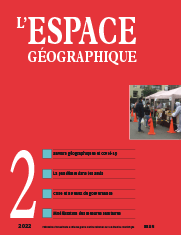

Covid-19
Geographic knowledge and decentralised visions of the Covid-19 crisis
Covid-19: An indicator of growing socio-territorial inequalities in Bolivia (1 fig.; 1 photo; 1 tabl.)
At the end of February 2021, Bolivia, the 79th most populous country, was ranked 4th in the world in terms of excess mortality rates attributed to COVID- 19. The measures taken by the Bolivian authorities to manage the circulation of SARS-CoV-2 revealed the persistence of significant inequalities between urban and rural territories. In some cases, they also exposed their exacerbation, despite the continuous implementation of policies to alleviate them since late 2005. The management of this crisis also highlighted the need for more reliable data in Bolivia. Data is indeed essential to better understand multifactorial phenomena such as a pandemic and to inform decisionmaking without intensifying socio-territorial inequalities.
keywords: BOLIVIA, COVID-19, INEQUALITY, SARS-COV-2, TERRITORY
The coronavirus pandemic in Ecuador: A spatiotemporal interpretation of mortality trends during the first year (4 fig.; 2 tabl.)
The coronavirus pandemic has disrupted the dynamics and functioning of territories worldwide, but its impact differs according to the areas and timeframes analysed, generating a diversity of spatiotemporal processes. Using mortality data from Ecuador, one of the worst affected territories, we analysed the spatiotemporal (hierarchical ascending classification) and multiscale (multiscalar territorial analysis) configuration of the pandemic. We conclude that the spread of the pandemic is due to two interlaced forms of complexity: that of nested spatial levels and that of nested organisational levels. The intersection of multitemporal and multiscalar approaches enabled us to identify territories with similar pandemic propagation characteristics, thereby providing useful knowledge for the territorial management of the pandemic.
keywords: CORONAVIRUS, MORTALITY, MULTISCALAR ANALYSIS, SPATIOTEMPORAL PROCESSES
How to curb the spread of a respiratory virus such as Sars-CoV-2 in an impoverished urban area? Lessons drawn from a spatial Multi-Agent System (13 fig.; 1 tabl.)
It is difficult, if not impossible, to produce reliable data on the circulation of a respiratory virus such as Sars-CoV-2 in specific socio-spatial contexts. With a Multi- Agent System, we were able to simulate the propagation of the virus in living spaces based on moments of proximity between agents. It was also possible to test containment measures, which, in real life entail various levels of participation by residents and civil society. The findings help understand processes and formulate hypotheses on the best options in terms of health efficiency. This case study, developed with the support of the Norcovid collective, is that of an impoverished suburban district in Marseille.
keywords: HEALTH MESURES, LIVING SPACE, MULTI-AGENT SYSTEMS, PANDEMIC, SUBURBS
Mobilising local grocers to impose lockdown on precarious urban populations: The case of a mediumsized Moroccan city (Tiznit) (1 fig.; 3 photos)
Lockdown policies to deal with the COVID-19 pandemic in lowincome countries immediately destabilised urban working classes, sometimes plunging them into extreme poverty. In Morocco, local grocers helped to reduce the tension between health and food security by granting the worst affected households credit to buy basic necessities. They acted as effective local mediators alongside security authorities. This example highlights the importance of institutional logics specific to territories and the mobilisation of stakeholders integrated in localised moral economies to overcome crises.
keywords: COVID-19, FOOD SECURITY, LOCKDOWN, MAROCCO, PANDEMIC
The impact of the Covid pandemic and tactical urban planning on bicycle facitilies in French cities (4 photos; 2 tabl.)
The Covid-19 pandemic has had multiple effects that were analysed geographically, particularly with regards to urban mobility. Among them, the bicycle boom in Paris and in most French cities was encouraged by major facilities prompted by tactical urban planning: temporary, small-scale, low-cost cycling facilities that prefigured permanent ones. However, some questions remained for us on the durability of this apparent transition towards a greater emphasis on cycling, and we drew lessons on these initiatives in terms of public space management and mobility practices and policies. First, we studied the way the pandemic had altered urban mobility. Secondly, we analysed how cycling enabled tactical urban planning to fully integrate land-use practices.
keywords: BICYCLE FACILITIES, FRANCE, POST-COVID, TACTICAL, URBAN PLANNING
Book reviews
In this issue of l’Espace géographique, you will find critical reviews of the following books
YÉGAVIAN T. (2022). Géopolitique de l’Arménie. Paris: Éditions Bibliomonde, 174 p. (Michel Bruneau, CNRS Bordeaux) ISBN: 978-2-36802-016-6
L’espace géographique 1/22![]()
![]() L’espace géographique 3/22
L’espace géographique 3/22
For subscribe or buy this issue: BELIN
![]() L’Espace géographique: contents
L’Espace géographique: contents
Last modified: November 4, 2023